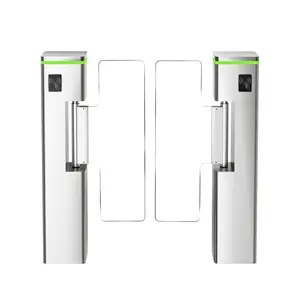
All categories
Featured selections
Trade Assurance
Buyer Central
Help Center
Get the app
Become a supplier

(1636 products available)








































Based on the working principle and structure, turnstile qr code readers can be divided into several types. They include the following.
These involve the simplest type of turnstile qr code readers. They have metal arms that rotate to allow people to pass after the code is scanned. When the code is scanned, the arm rotates, allowing the person to pass. They are easy to install and very inexpensive and thus good for low-security areas. However, they have low speed and capacity.
These have a combination of mechanical parts and electronic systems. The electronic system uses a QR code to unlock a mechanical barrier. They are more secure than the former and use less power. However, more costly and complex to install and maintain.
These solely depend on electronic barriers controlled by QR codes. The anti-passback feature prevents users from entering more than once with the same code. Employees can be notified if a jam happens. Electronic turnstiles have smooth and silent barriers, making them suitable for modern buildings. However, they are the most expensive and complex type.
These aslo called “flap barriers” or “glass turnstiles”. They don’t have mechanical barriers. Instead, they use glass or acrylic flaps that open when a QR code is scanned. This sleek design is used for high-traffic areas. Moreover, they are less secure than mechanical ones and have a slower throughput compared to others.
The choice of which type to use will depend on security needs, budget, and property style.
Turnstile qr code readers are important for controlling access to restricted areas. Here are some key factors to consider when selecting a turnstile qr code reader.
Consider the required security level for the specific application. Higher security environments such as data centers or government buildings may need more secure types, such as electronic or optical turnstiles. For less secure areas, mechanical or electromechanical turnstiles may suffice. Furthermore, opt for options with anti-passback and alarm features for enhanced security.
Determine the expected user traffic rate. Some turnstiles have features for running faster QR code readers to allow more people to pass in a short time. This is known as throughput speed. For instance, an electronic turnstile may be better for airports and train stations. However, at lower volumes, speed may only be slightly important.
These include how the turnstile can work well with existing systems. For example, some can work well with access control systems, visitor management software, and building management systems. It is crucial to ensure the new *turnstile gates for humans* integrate with such systems.
The durability of the turnstile is highly important since many people use it constantly. All the options are made of strong stainless steel. Other factors to consider are whether the area is indoors or outdoors. Furthermore, factors like weather, humidity, and temperatures are worth considering. They can affect how durable the turnstile is.
Assess the costs. Maintenance requirements are also worth considering since they directly impact the overall costs. Usually, mechanical turnstiles cost less. But they may need constant human maintenance. Complex electronic models may have high initial costs but require low maintenance.
A turnstile qr code reader can ensure security in restricted areas. This is done by controlling entry. Here are the steps on how to use turnstiles.
These are ideal for popular settings. In corporate offices, they help control who enters and keep out. They also track records of employees who enter or leave. At events, they manage guests and help avoid crowds. In factories, they make sure only authorized people enter working areas.
Get the QR code from the security app or website. Then, walk up to the turnstile. The QR code reader is on the turnstile. So, hold the QR code near the reader. The reader checks the code quickly. If the code works, the turnstile unlocks. Now, walk straight into the turnstile. It will turn a bit to let the person pass. After everyone passes, the turnstile locks again. Some turnstiles beep. Others have colored lights to show if the code worked.
Following proper care guidelines will help keep the *automatic turnstile doors* secure and working properly. Here are ways to help with the storage and transport of turnstile QR code readers.
A1. The main benefit is speed. QR codes allow fast scanning for quick entry. They are also cheaper than many other electronic locks. In addition, they are easy to manage and update. This offers flexibility without extra hardware costs.
A2. Several industries are helped. Event venues like concerts and shows use them to handle tickets. Public transport apps also use them to control bus and train entrances. Offices use them to manage workers and visitors. Even factories use them to track who enters working places.
A3. It is best to focus on three main features when choosing a turnstile QR code reader. Select one that integrates smoothly with other systems. Good speed and accuracy are also very important. Plus, increased security features provide extra protection.
A4. Yes, many options are made for outdoor use. They are shielded from things like rain, dust, and temperature swings. Strong materials like stainless steel keep them safe from the weather. They add security to outdoor spaces like parks and event venues.
A5. Regular maintenance is required to keep the turnstile QR code readers working well. Every six months, a check of all electronic parts and a cleaning of the QR code reader from dirt or dust is needed. All software updates must be done as soon as released for better security and smooth use.